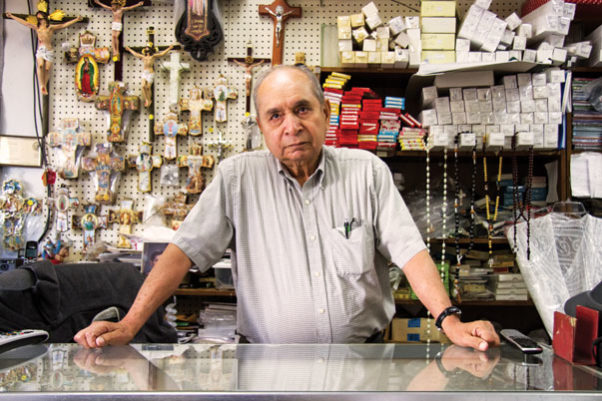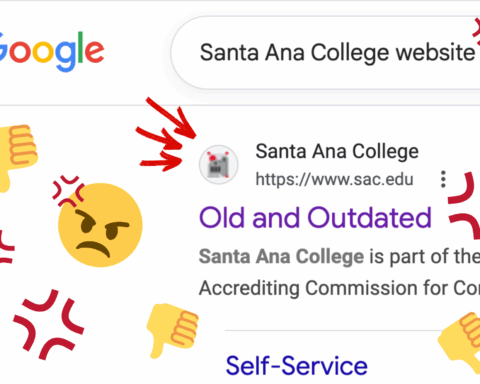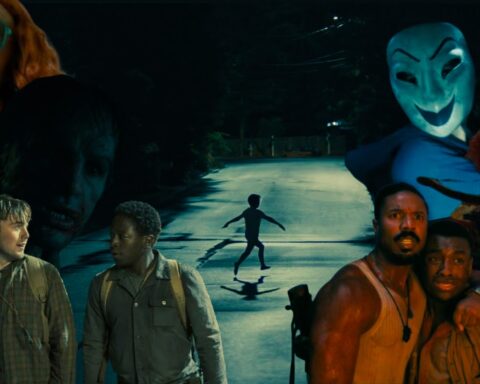
By: C. Harold Pierce
Sam Romero sits behind the counter of St. Theresa’s Catholic Gift Shop while watching a Spanish language movie on a 12-inch television. A middle-aged woman breezes in. Romero is startled. It was his first customer in more than two hours.
Rosaries, crosses and paintings of the Virgin of Guadalupe hang from the walls of Romero’s cluttered shop. Behind the counter, stacks of documents and newspaper clippings are piled beside Romero’s handmade signs.
One reads “Stop Ethnic Cleansing.” In 2011, Romero plastered dozens of the signs on storefront windows and lampposts around downtown.
For decades, the four-block strip of retail shops and restaurants, now branded as the East End of Downtown Santa Ana, was known as Fiesta Marketplace, an impromptu meeting space that simulated Mexico’s plazas — the hub of a city or town’s social life. Bands would blare bachata on the weekends. Children waited in line to ride the colorful carousel that was once the downtown landmark.
But Romero’s neighbors and clientele have changed.

Gone are many of the bridal stores, swap meet malls and jewelry exchanges, replaced by urban-oriented retailers like Bespoke Cut and Sew, a trendy baseball cap store where hats are displayed on the walls like pieces of art. Vapor Lair is an e-cigarette specialty shop where customers are offered puffs of vapor as they walk through the door. Both squeeze Romero’s store like unwanted hugs from a lifelong enemy.
“All the chips are stacked against mom and pop shops. In about five to 10 years, the Latino business district will be only in the history books. Adios,” Romero said, counting more than 20 businesses that have lost their leases in the past year.
Change seems to come in generational waves.
Downtown Santa Ana was dotted with beer halls. Prostitutes plied their trade and gangs counted it as part of their territory. In the mid-1980s a group of property owners banded together to create Fiesta Marketplace, a family-friendly shopping center geared towards serving the Spanish-speaking community.
In 2011, the carousel was removed. With it went the Hispanic customer base, Romero said.
But Ryan Chase, the property manager for S&A Management, sees it as a natural shift in demographics.
“These businesses which have always banked on immigrant customers can’t compete because that immigrant customer has gone away,” Chase said.
He oversees about four blocks of real estate that’s gone through an extreme makeover.
Chase darts around the East End checking on tenants while explaining his vision for Downtown Santa Ana as an eclectic melting pot and haven for local artists, similar to New York’s Soho District, Chase said.
The younger crowd has embraced it. The older ones have resisted.
Signs reading “nos movemos” drape across storefronts and “close-out sale” banners hang from window shops on Fourth Street.
“This whole building will be a food court next year,” Chase said, pointing to an indoor swap meet where vendors hawk technicolor gowns, lucha libre masks and CDs of bands and mariachi music.

With about 20 new shops and restaurants opening in less than one year, the East End has developed at a furious pace, Chase said. But some local shop owners accuse Chase and his family of pushing out Latino businesses and gentrifying the area.
The city has subsidized some of the development with a $1.25 million rebate program for property owners to renovate storefronts. S&A Management received about three quarters of that money to fix up four buildings.
In 2008, a tax was imposed on business owners in Downtown Santa Ana to fund Downtown Inc., an organization formed to promote and provide security in the area.
But shop owners say that their tax dollars did not benefit their businesses, instead providing security only for establishments that are open late at night.
An Orange County Grand Jury found in 2011 that business owners were taxed illegally and money benefited a select number of merchants.
“I thought, my God, they don’t want me here,” Romero said, adding that the removal of the carousel and loss of surrounding Latino business owners has resulted in a decline in foot traffic and a 60 percent decrease in his sales.
Chase denies that redevelopment is to blame for driving away immigrant customers.
“Things have changed, and unfortunately a lot of people down the street have not changed for a long time and think that it’s all our fault. They want to blame someone, but it’s not us,” Chase said.
Five years ago, Chase warned tenants about changes in the marketplace. “A lot of them took it the wrong way and thought we were telling them what to sell,” he said. Since then, few have adapted to the changes, choosing instead to close shop or move elsewhere.
Downtown Santa Ana
[img_reflect_left src=”http://www.eldonnews.org/wp-content/uploads/2013/10/1-gentrify-timeline-arvhice.jpg”] 1919
Downtown is in its infancy, attracting merchants from across the nation.
[img_reflect_left src=”http://www.eldonnews.org/wp-content/uploads/2013/10/2-gentrify-timeline-1960-ARCHIVES.jpg”] 1960
The Yost, then a Spanish-language theater, drew Latinos into town.
[img_reflect_left src=”http://www.eldonnews.org/wp-content/uploads/2013/10/3-gentrify-timeline-archives.jpg”] 1985
Fiesta Marketplace, a family-oriented shopping plaza, gains popularity.
[img_reflect_left src=”http://www.eldonnews.org/wp-content/uploads/2013/10/4-gentrification-playground-monroy.jpg”] 2013
Trendy new shops open and the area is rebranded as the East End.
- In Photos: Fiestas Patrias 2025 - September 25, 2025
- The two-party system is failing us. - October 19, 2024
- Read our Fall 2023 Print: Vol. 100 No. 1 - October 23, 2023












He’s out! Bye, bye Saint Theresa’s! Your horrible attitude and downright MEAN spirit will NOT be missed! Space for lease! Haha!